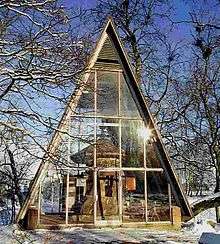Dionizas Poška
Dionizas Poška (October 1764 – 12 May 1830) was a Lithuanian cultural figure of the early 19th-century Samogitian Revival, the early stage of the Lithuanian National Revival. Born to a family of petty Samogitian gentry, Poška attended Kražiai College and worked as a lawyer. He dedicated the last decade of his life to cultural work. He had wide interests in the Lithuanian language, culture, and history. He collected archaeological artifacts and antiques and stored them in Baublys (plural: Baubliai), which is considered to be the first Lithuanian museum. Poška wrote many works but during his life he published only a letter poem and two articles on history. His most famous work is epic poem "The Peasant of Samogitia and Lithuania" (Mužikas Žemaičių ir Lietuvos). He also compiled a trilingual Polish–Latin–Lithuanian dictionary but did not finish it.
Biography

Until 2004, the place and date of the birth of Poška was unknown. His year of birth was subject to varied speculations that ranged from 1745 to 1775. In 2004, historian Povilas Šverebas discovered Poška's baptismal records of the Žemalė church. He was born in the Lėlaičiai manor between Telšiai and Mažeikiai in a family of petty Samogitian gentry and was baptized in Žemalė on 13 October 1764. His childhood passed at his parents' estate in Maldūnai (Šilalė district). Between 1773 and 1780, Poška studied in Kražiai College. Later he studied law at the barrister's and until 1821 held various offices at the courts. In 1786 Poška became a lawyer. Since 1790 till his death Poška lived in a small estate of his own in Bardžiai (Raseiniai district) near Bijotai, where he possessed around 500 ha of land and had 40 serfs. In 1792, Poška married Uršulė Sasnauskytė. They had no children.
Poška was actively corresponding with professors of Vilnius University, bishops, poets, writers and other cultural figures of Lithuania. Poška died in 1830 and was buried in Kaltinėnai cemetery (Šilalė district municipality) near his wife.
Baublys
Poška was a person of wide interests. He knew Lithuanian (native Samogitian dialect), Polish, Latin, Ancient Greek and other languages. His special interest laid in the past of Lithuanian nation, its language, spiritual and material culture. Poška collected ancient artifacts from archaeological excavations, military arms of the times of the Grand Duchy of Lithuania, Lithuanian coins, medals and other rarities. A library of rare Lithuanian-language books was too collected by Poška.
At the beginning of the 19th century Poška cut down an oak, that was growing in his estate, when the oak began to dry up and hollowed its trunk thus making a hut for the collection of his antiquities, that was called by Poška himself – Baublys (Baublys in Lithuanian means someone or something, who/that make a low roar, rumble), because of a characteristic sound when the wind was blowing through this trunk. In 1812 in this carved oak tree he established the first historical museum in Lithuania. Later more old oak trunks were carved for the collection of Poška to store.
This museum soon became widely known not only in Lithuania, but also abroad and played an important role in encouraging Lithuanian nobility and the rest of Lithuanians to study the past of Lithuania. Today Baublys is a working museum, that depicts one of many initiatives of Lithuanian nobility during the Romanticism period, when the interest in the history of Lithuania was growing. Poška was one the first Lithuanian nobles, who felt interested in various Lithuanian antiquities.
Literary work
Poška was writing in his native Lithuanian and in a nobility language of the time – Polish language. During his lifetime, he himself did not publish much or tried to preserve his writings, thus part of his works and translations were lost. His literary heritage consists mostly of historical, philological and fiction works.
Poška was collecting historical books in Lithuanian language, wrote his own works on Lithuanian past, language, ethnography and mythology. From 1825 to his death he was working on a trilingual Polish–Latin–Lithuanian dictionary. The unfinished dictionary consists of more than 25,000 words. The last entry is sanie (sled).
The fiction works of Poška vary in form: they consist of long poems as well as short epigrams. The most famous literary work of Poška is "The Peasant of Samogitia and Lithuania", that was written by him during a ten-year span between 1815 and 1825.
Today Poška is respected in Lithuania not only as a creator of the first Lithuanian historical museum and one of the first poets, who wrote in Lithuanian language, but also as one of initiators of the early 19th-century informal Lithuanian cultural movement to revive the Lithuanian culture and Lithuanian language, the so-called Samogitian-Lithuanian revival (Žemaitiškas lietuvškasis sąjūdis).
Poška also coined some neologisms, that are still used in Lithuanian language and was making first attempts of standardisation of Lithuanian language.